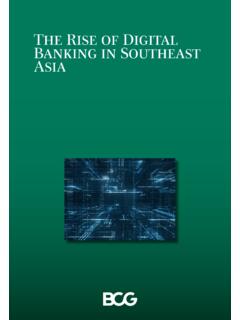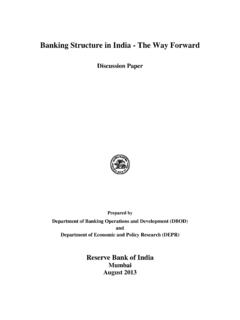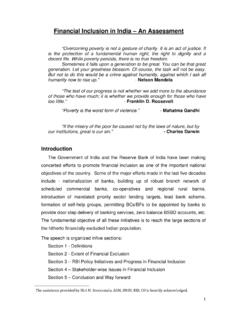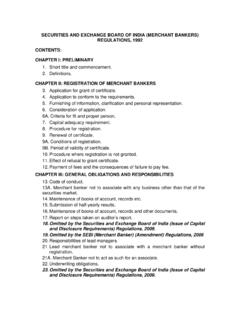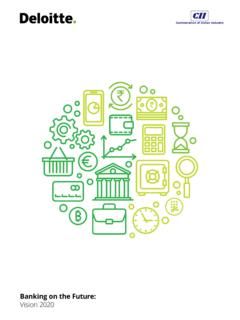Transcription of FinTech in India Ready for breakout - Deloitte
1 FinTech in India Ready for breakoutJ ul y 201702 Brochure / report title goes here | Section title goes here 03 FinTech in India | Ready for breakoutForeword by IAMAI 04 Message by Deloitte 05 Introduction 06 Indian FinTech segments 09 Indian FinTech Scenario: To stay and to grow 11 breakout of FinTech companies 13 Key factors leading to success of FinTech companies 13 breakout FinTech Segments 14 Alternate Lending 16 Payments 22 Investment Management 27 Banktech 30 InsurTech 32 Personal Finance Management 33 Key challenges for Indian FinTech 34 Regulations: Balancing Act to foster innovation 34 Gain trust and improve perceptions through literacy 34 Financial Infrastructure and utilities 34 Cyber and Data security 34 Conclusion 35 Appendix 36 References 39 About IAMAI 40 About Deloitte 41 Acknowledgements 42 ContentsFinTech in India | Ready for breakout04 Since it s formation, IAMAI has worked extensively with our industry members to foster a more inclusive and enabling digital ecosystem in India .
2 Through the efforts of the Payments Council of India (PCI) and IAMAI s FinTech Committee, we are excited to work towards India s transition towards a less-cash, more diverse and financially inclusive economy that is geared towards introducing an ever widening population to Digital financial services. Our belief is that this transition will be best brought about through deep partnerships between incumbent banks, new world disrupters and the government. The structure of our organization and all our efforts echoes this belief, which is why we eschew an us versus them mentality in favor of a close-knit, partnership based report explores some of the most pertinent trends that are at the root of the FinTech revolution currently underway in India . We will follow it up with a series of deeper dive analyses which will get into more details about the underlying causes and regulatory / industry changes required to usher in the FinTech age in India . Subho Ray President, IAMAIF oreword by IAMAIFinTech in India | Ready for breakout05 Message from DeloitteMonish ShahPartner Financial Services FinTech is one of the fastest emerging areas in banking and financial services.
3 It is making the experience of banking and finance more intuitive, personalized and empowering. The convergence of financial services and exponential technologies will be key to build a strong digital economy, and lead India s transformation. Armed with new data and analytics capabilities, asset light platform and almost zero processing costs, FinTechs are complementing and in some cases challenging the traditional banking and financial services institutions globally. Indian FinTech is one of top five markets by value of capital funding and investments in the sector with nearly $270 million of funding in 2016. India remains one of the largest markets where the structural enablers to setup and incubate FinTech have come together strongly and at an apt time. Combination of steady economic growth with low penetration of financial services and availability of supporting infrastructure such as internet data access, smartphones along with utility infrastructure including Aadhaar based authentication and India Stack capabilities are likely to provide the required impetus to India s FinTech sector.
4 We have analyzed the breakout potential of India s FinTech sector across six segments - Payments, Credit, Investment Management, Personal Finance Management, BankTech and InsurTech and across twenty sub-segments. Expectedly payments and lending are the likely candidates for breakout in the short term as the new FinTechs target the quest for offering cashless digital payments services. On the lending side, low penetration of retail and MSME credit along with the promise of better experience and faster turnaround time have created strong propositions for customers. Fintechs in most of the other segments including Investment Management, Personal Finance Management, BankTech and InsurTech have initiated the market making process and currently target specific market niches. We believe that armed with right value proposition and by gaining confidence of customers, these segments are likely to witness their own break out moments and it s just a matter of time, and some entrepreneurial energy and creativity before it happens.
5 We hope that the industry finds this report useful in charting direction for a sustainable, and scalable FinTech sector in in India | Ready for breakout06 IntroductionTechnology has been a key enabler in the growth of a digital economy. Over the years, Indian banks and financial services providers have gradually adopted technology to improve reach, customer service and operational effectiveness with evolving market and technological advances. However, the pace of technology adoption has not been commensurate with it's potential and hence there have been gaps in the penetration of financial services. For example, there is a credit demand supply gap in the Micro and Small Enterprise (MSE) segment particularly for micro enterprises. We estimate the credit gap in the MSE segment (with annual revenue upto INR 3 crore) to be INR 833,000 crores. Exhibit 1: Credit gap in the MSE segmentSource: Deloitte Analysis, MSME Annual Report, RBI, Industry ReportsNote: Credit Demand is calculated based on revenue using appropriate multipliersRevenue Segment (INR)No.
6 Of Units (Mn)Credit Demand (INR 000 crore)Bank Credit Supply(INR 000 crore)Credit Gap(INR 000 crore)<15 L ak - 30 lakh - Crore - 3 Crore - 18 gap in the target segment is INR 833k Crore or >60% of credit demand of target segmentFinTech in India | Ready for breakout07 Exhibit 2 FinTech Convergence of Financial services and Technology Source: Deloitte Internal AnalysisBankHardware ProvidersPaymentsSoftware providersNBFCC loud providersSecurity BrokingPlatform providersWealth ManagementDistributionFinanceTechnologyF inTechTraditional Banks and Financial Institutions have viewed technology as an enabler to business propositions, rather than creating new business propositions themselves. Financial Technology ( FinTech ) Companies however are changing that role by leveraging digital technologies to create new business propositions and target new market segments which hitherto were not possible. FinTech in the truest sense is the application of technology to offer new financial products and services to new market segments in an economically viable manner.
7 From a business model perspective, the FinTech sector is marked by technology companies that either intend to disintermediate, or partner with incumbent Banks and Financial Institutions depending on strategic narrative and market landscape. Hence, FinTech is increasingly becoming an important focus area for all the key stakeholders in India s Financial Services industry Regulators, Traditional Banks, NBFCs, Payment Banks, Investors, Payment Service Providers, Broking and Wealth Management Companies, Insurance providers and pure-play FinTech players. Armed with advanced data and analytics capabilities, asset light platforms and almost zero processing costs, FinTech companies are complementing, and in some cases challenging the traditional banking and financial services institutions. The immense potential of this sector is clearly apparent in the global FinTech funding scenario. With more than $17 Bn funding and over 1400 deals in 2016, FinTech is one of the most promising sectors globally.
8 With nearly $270 Mn funding in 2016, India is ranked amongst the top ten FinTech markets globally. FinTech in India | Ready for breakout08 $500m $10m< $10m $100mGlobally, $ Bn invested over 1,436 deals in 2016 Source: PitchBookCompiled by: DeloitteCanada $183mUS $ $72mBrazil $161mIsrael $17 3mSouth Africa $15mSingapore $86mNew Zealand $7mAustralia $91mIndonesia $5mHong Kong $170 mTai wan $6mJapan $87mChina $ b nIndia $272mRussia $7mPoland $1mCzech Republic $6mSweden $62mNorway $ $783mIreland $524mLuxembourg $2mFrance $68mSpain $12mItaly $9mSwitzerland$12mDenmark $32mBelgium $28mNetherlands $20mGermany $384mMalaysia $4mThailand $19mTurkey $17mIsrael $17 3mIn India , most of the FinTech companies including the exponentially growing m-wallets have been complementing existing financial services providers, rather than completely disintermediating them. Traditionally, the Indian financial services sector is characterized by brick and mortar - branch banking , labor intensive banking services, manual and paper based processes with limited straight through processing-despite continuous investments in technology and systems by Indian Banks and Financial Services Institutions.
9 Hence, there is a very high degree of customer friction in the areas of customer on-boarding, KYC and branch banking services. This inefficiency in the system presents an inherent opportunity for data-driven analytics led FinTech business models in reducing cost of acquiring and servicing customers, eventually leading to a greater penetration of financial services and insurance products in the market. Exhibit 3 Global funding to FinTech sector in 20161 in India | Ready for breakout09 Although Demonetization provided a boost to the payments sector in the short term, but we now expect investments in personal finance and wealth management to rise going forward. There are a number of new business models that are being introduced in urban centers. There are a limited number of players that are focused outside urban and metro centers due to infrastructure challenges ( rural India has only 17% internet penetration compared to 60% in urban India )1. We believe that in the medium term FinTech players will consolidate their position in urban and metro centers and will extend to rural and semi-urban areas over the next 3-5 years.
10 The purpose of the paper is to analyze the Indian FinTech Landscape, the likely breakout of different FinTech segments in the Indian context, their likelihood to scale, and implications on the Indian Financial Services and Insurance FinTech segmentsIn the Indian context, FinTech can be broadly aligned across the following twenty segments, across six broad financial services areas. The twenty segments are described in Exhibit 4. The contours of these segments are broadly in line with the findings of Deloitte global research on Future of Financial Services , which was jointly conducted along with World Economic Forum and highlights the emerging areas of innovations in the financial services sector. As inferred in the study, these innovations are also clustered around specific areas with unique underlying characteristics. FinTech companies are leading the charge at pioneering these innovations and are continuously re-shaping the market landscape, even in India . Within these segments, Digital Payments have been at the forefront of leading India s FinTech sector.











